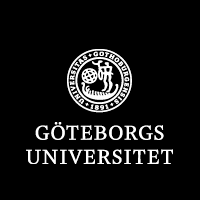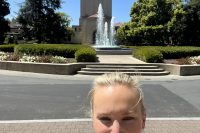
RESEARCH. Fish have a better memory than their reputation would suggest; Petronella Kettunen’s zebrafish are living proof of that. Because the small fish’s head is transparent, it’s an excellent model animal for her basic studies on how memory works. With the fish as a model, she is also contributing to the search for drugs to treat Alzheimer’s disease.
To use fish for memory research, they must, of course, be able to remember things.
Everyone has heard that goldfish have short memory, and this is one of the myths that Petronella often debunks when giving one of her many popular science lectures.
“Memory is a subject people are interested in and that many would like to know more about. When I give lectures to the public, I often demonstrate how readily our brain associates and creates false memories, which many people don’t know. Another thing that often surprises people is that there is so much that we don’t actually know when it comes to memory,” she says, mentioning as an example that it’s not yet known exactly how we create our long-term memories.
“Memories that the brain is going to save are moved to a new location in the brain. We know that these long-term memories migrate from the hippocampus to the cortex, but nobody knows exactly how that happens.”

Transparent head
Although the memory of goldfish is far better than rumored, this is not the fish that is helping Petronella understand the cellular and molecular mechanisms of memory and learning. But like goldfish, the species she works with also is frequently seen in aquariums: the zebrafish. It’s an active and social fish that lives in schools. In addition to the fact that it’s easy to raise, the zebrafish possesses another great advantage for research: before it becomes full-grown, its head is transparent. Consequently, the neurological processes inside the brain can be examined with a microscope in live animals.
Petronella learned techniques for working with zebrafish as a postdoctor in California, and the group she then established in Gothenburg when she came back to Sweden was one of the first in the Nordic region to make use of zebrafish to study how the brain works. She explains that she had no previous ties to Gothenburg, and it was just by chance that she ended up right here:
“I moved here because there was a functioning fish facility in the hospital that I could use,” says Petronella. “In retrospect, I can affirm that moving to Gothenburg was a good choice, because it has involved good clinical connections for what was originally a purely basic research project,” says Petronella.
Inflammation in the brain is linked to memory
 Her research team has developed a zebrafish model to study microglia, a type of cell in the brain that protects the brain against bacteria and hazardous substances by eating them up and breaking them down. More recently, it has been demonstrated that microglia also play an important role in our learning, and learning difficulties have been linked to inflammation in the brain that microglia control.
Her research team has developed a zebrafish model to study microglia, a type of cell in the brain that protects the brain against bacteria and hazardous substances by eating them up and breaking them down. More recently, it has been demonstrated that microglia also play an important role in our learning, and learning difficulties have been linked to inflammation in the brain that microglia control.
“The inflammation itself doesn’t need to be bad; it’s even necessary. But if the inflammation becomes overactive or chronic, it has bad consequences. The question is whether we can help the brain achieve a balanced inflammation, and in that case what that balance should look like?”
Microglia are also the cells that make the enzymes that break down beta-amyloid, a toxic protein that accumulates in the brain in Alzheimer’s disease and that is thought to be the cause of the disease as well.
“When we get older, the cells become less able to secrete the enzymes that break down beta-amyloid. A possible path toward a new drug could be finding ways to give microglia a boost so that the immune cells retain their vitality and can continue to break down the harmful protein,” Petronella speculates.
Testing antibodies in fish
She has developed collaborations with eminent Alzheimer’s researchers both at the memory clinic and at the neurochemistry laboratory in Mölndal and also collaborates with pharmaceutical companies both here in Gothenburg and in Oxford, where she is a senior visiting research fellow at the university.

The Gothenburg company, Alzinova, has an antibody that has proved in preliminary trials in fish to be capable of removing toxic forms of beta-amyloid, but that has not yet been tested on people.
In some experiments the zebrafish larvae swim in chemicals, and the research team is studying how the fish’s behavior and brains are altered. Petronella brings up an image of a fish’s brain on her computer and points to the screen:
“Here we are looking at a transgenic protein that causes microglia to be lit up in green. We can look into the living larvae’s brains in real time and film when something exciting happens in their brains – for example, when chemicals and drug molecules interact with beta-amyloid and microglial cells.
Creating memories
They are also studying how the fish’s behavior is affected by different substances. Giving repeated, mild shocks to the fish reinforces their flight reflex, which is also a kind of memory. When the fish have learned the flight behavior, the researchers can affect their brains in various ways. For example, they can inject molecules that block the signal paths or inject substances believed to be harmful to memory, such as beta-amyloid, to see how this affects the fish’s brains and their ability to learn the behavior.
As a doctoral student at Karolinska Institutet, she worked with a very different fish –lampreys. It’s a long and narrow cyclostome, which zoologists classify as a precursor to more modern fish.
“Since the lamprey’s nervous system is simpler than ours and is dominated by a long spinal cord, it is used a lot to study spinal cord physiology. It’s a great animal to begin work with as a doctoral student, when you are learning to work experimentally in neuroscience,” says Petronella.
A historical perspective

It was after her dissertation in 2004 that she made her way to UCLA in California. As a postdoctor in Los Angeles, she managed to not only learn to work with zebrafish, she also took the opportunity to develop another interest: history. Along with Mariette Manktelow, a botanist and Carl von Linné researcher in Uppsala, she wrote a book, The Women Around Linnaeus, that explores what it was like to be a female researcher during the 18th, 19th and 20th centuries.
“Historically, things have gone up, and then down, for female researchers,” Petronella asserts.
“During the 18th century there were quite a few women who were interested in science, including Carl von Linné’s daughters, who were very talented and who also contributed to the development of science. During the time when written correspondence between researchers was the most common way to discuss studies and results, the contributions of women also were more accepted. When the scientific academies were established, it became a clearly male realm. In the late 1800s, for example, a British woman who now is primarily known for her illustrations, Beatrix Potter, handed over her findings to a male friend, who was the one allowed to present them to the Linnean Society in London. What if she had been allowed to continue with her research? What findings may male prestige have prevented through the centuries?”
TEXT AND PHOTO: ELIN LINDSTRÖM CLAESSEN










